
Preserving a Major Investment: Upgrading From a VC820 to an i850
By Joel Hruska
Date: January 17, 2002
Itís an unfortunate truth that computer hardware ages quickly and is only cutting edge for a short period of time. Todayís high end machine becomes yesterdayís barely adequate computer and last weekís ancient box within a depressingly short amount of time and repeat business forms a critical part of the bottom line results for all OEMís.
Given the cost of a new computer, however, many users choose to upgrade rather than buy a completely new system, especially if the original system was expensive. Today, Iím specifically looking at one of the most expensive systems ever released and examining its upgrade options.
The VC820 was Intelís first attempt at an RDRAM-based motherboard and was a disaster for the Santa Clara chipmaker. The project suffered numerous delays, engineers were unable to route the traces for three RIMM slots, forcing them to leave one out, and the price of RDRAM was hideously expensive. In an attempt to bypass this, Intel designed a MTH (Memory Translator Hub) which would allow a VC820 board to use SDRAM (albeit with a significant performance hit). The MTH design was flawed, however, and Intel was forced to recall all VC820 boards using it and replace its flawed SDRAM design with RDRAM.
RDRAM was hideously expensive at the time and when benchmarks were published on Intelís own website showing SDRAM-equipped motherboards beating VC820ís equipped with RDRAM, it was the final straw. Prices for RDRAM ranged from over $1500 for 128 meg to around $600 as time went by, but RDRAM was always horribly priced for the period of time VC820 was on the market.
===================================
Why Upgrade to i850?
The incredible expense of RDRAM is the hinge on which this entire upgrade article turns. A customer purchasing a VC820+RDRAM may have paid anywhere from $1200 to $2000 for the RAM only 18 months ago. Given the enormous cost of the RDRAM, itís completely understandable that the purchaser might want to get additional usage from it in his next systemóand the P4 is certainly better-equipped to use RDRAM as a memory platform than the P3 ever was.
While itís true that the AthlonXP+DDR platform offers a more cost-effective upgrade solution than the P4+i850, again, this article is dependent on the fact that the customer would like to continue to use the ultra-expensive memory he paid such a high price for. At present, i850 is the only solution available which would allow him to do so. In addition, there are certain customers who prefer Intel products and may not wish to consider an AthlonXP+DDR solution.
===================================
System Configuration
VHJ would like to thank Intel for providing us with a 1 GHz P3 and reference i820 motherboard.
DDR memory itself has also gotten much more expensive over the last few weeks, due at least partially to the launch of Intelís DDR-equipped i845 chipset. As a result of this price shift, DDR and Rambus are now closer to price parity (though DDR does continue to hold a small-to-moderate advantage depending on manufacturer and vendor). While RDRAM has been largely panned by the tech industry for a huge number of reasons which I wonít discuss here, it remains the highest-performing memory Intel supports on its own chipsets. Since this article is premised on the idea of a consumer wishing to continue to use RDRAM in a system I wonít be discussing Intelís i845d much, save to note that it offers performance very close to the i850, keeps the customer on an Intel platform (if such is his desire) and avoids the myriad issues surrounding RDRAM.
|
Initial System Configuration |
Upgraded System Configuration |
|
P3 1 GHz |
P4 2.0 GHz |
|
VC820 Motherboard |
MSI Pro 5 i850 Motherboard |
|
256 Meg RDRAM |
256 Meg RDRAM |
|
NVIDIA GeForce2 Pro |
NVIDIA GeForce2 Pro |
|
Seagate Barracuda ATA/IV |
Seagate Barracuda ATA/IV |
|
Win 2K w/ SP 2 installed |
Win 2K w/ SP 2 installed |
|
Detonator Drivers version 21.83 Installed |
Detonator Drivers version 21.83 Installed |
|
DirectX 8.1 Installed |
DirectX 8.1 Installed |
|
Intel Chipset INF Drivers Installed |
Intel Chipset INF Drivers Installed. |
===================================
Notes
It is highly unlikely that many buyers out there are using a 1 GHz P3 + RDRAM motherboard. P3ís at that speed were extremely rare at the time that the VC820 was Intelís flagship motherboard. They were all but impossible to find in the marketplace, even OEMís rarely carried them. The expense would also have been huge as such a system wouldíve cost four to five thousand dollars. Owners of lower-clocked P3ís + RDRAM, however, can simply look at the scores achieved and realize the performance delta between the P3 and P4 would be even greater should they choose to upgrade.
Only 256 Meg of RDRAM was used because of the expense of RDRAM at the time.
Similarly, a GeForce2 Pro was used rather than a GeForce 3 so as to demonstrate a card that sits mid-range between both boxesí capabilities. A GF2 Pro in a P3 system would represent a significant graphical upgrade to the power of that box, while remaining a useful video card for the P4 today.
With all that said, letís take a look at the performance of the two platforms.
===================================
The Tests
Sysmark 2000 and 2001
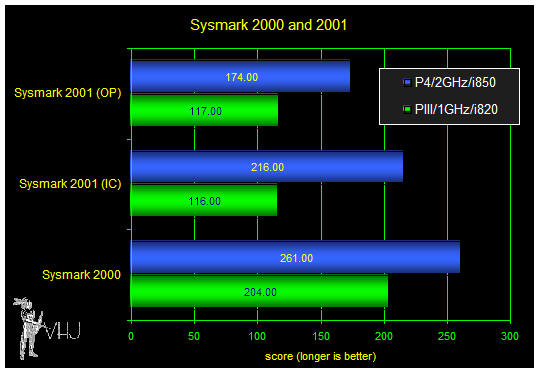
In Sysmark 2000 you see a noticeable difference between the P3 and the P4, though the difference is not nearly as large as one might expect. The P4 scores 20% higher than the P3, but is clocked twice as fast.
Some of you may remember that back in September VHJ did an article on the P4ís IPC as compared to the P3. The results of that article showed the P4 performing at about 60% the IPC of the P3 (IPC=Instructions Per Clockóthe indicative IPC number I refer to is reached by dividing the score in the benchmark by the processorís clock speed). That result proves to be true here as well. 60% of the P4ís 2 GHz clock speed is 1.2 GHzómeaning that, in this particular test, a P4 2 GHz only performs about as well as a theoretical P3 1.2 GHz.
Not the best showing for the P4, but itís also only one benchmark. Letís move on to the newer and more bandwidth intensive Sysmark 2001.
Sysmark 2001 Internet Content Creation
Here you see the tables turn decisively as the P4 explodes past the P3 and wins the benchmark by almost 50%. In this test you see the P4 scaling excellently. The P4 is twice as fast as the P3 and performs nearly twice its score. It is important to note that the ICC section of Sysmark 2001 is heavily weighted towards bandwidth intensive benchmarks that favor the P4, but at the same time, anyone working in an office doing this type of work or using the programs featured in this section of the benchmark should pay attention.
Sysmark 2001 Office Performance
In the section of Sysmark 2001 that focuses more on Office-oriented benchmarks the P4 outpaces the P3 by a comfortable 33% margin. While the well-known IPC penalties of the P4 continue to be in effect, a 33% performance gain is definitely noticeable and can make a difference when performing multiple tasks simultaneously.
These next tests look at the memory subsystem and latency aspects of the chipsets. RDRAM has long been known to have much higher latencies than DDR-RAM and yet the P4 was designed to aggressively combat latency with its ultra-low latency L1/L2 cache structure. How much of a difference does the dual-channel structure of the i850 and the P4ís low latency design make when compared to VC820?
===================================
Bandwidth Burn
Memory bandwidth is the rate at which data can be transferred from memory. Modern CPU's are beginning to severely outpace the performance of their memory subsystems, so much attention has been given recently to memory bandwidth.
VHJ has recently enhanced our COSBI test for memory bandwidth. BandwidthBurn now extracts much higher transfer rates for cache, while main memory bandwidth has increased for every CPU other than the Intel Pentium 4, which enigmatically declined by about 10% although P4 cache throughput skyrocketed. As with all COSBI tests, the source code is available.
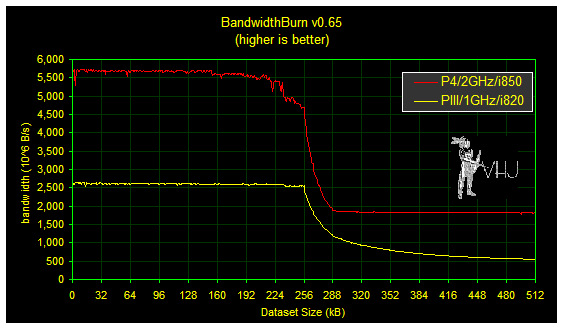
[ed: Inside cache, the two chips actually perform similarly since cache bandwidth scales with clockspeed. In main memory, however, the P4 dominates because its 400MHz bus is simply a much fatter pipe than the skinny 133MHz straw that the PIII sips with. Outfitted with its unbalanced half-brother's faster cache, the PIII would likely be able to demolish the P4 on many applications, even when running at much lower clock speeds.
Note how the PIII's bandwidth slopes gently from cache to main memory. This is a nice characteristic specific to the PIII core.]
===================================
MemLatency Plus
This component of COSBI measures a system's speed at performing random assignments from a million element 32-bit integer array to random targets in another million element 32-bit integer array. Such operations are highly memory latency dependent.
Like BandwidthBurn, MemLatencyPlus takes measurements over increasing dataset sizes thereby showing the influence of cache as well as main memory.
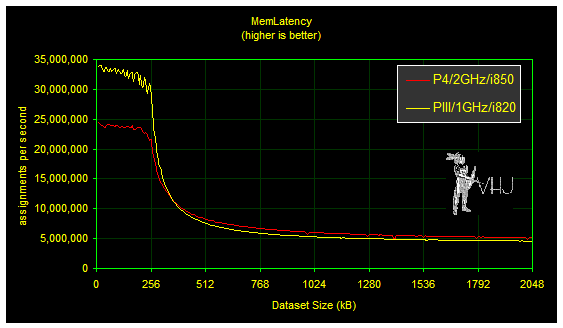
[ed: Perhaps surprisingly, the PIII pounds the P4 on datasets that fit into cache, despite the fact that the PIII is running at only half the clock speed. However, the P4/i850 performs a little better in main memory on MemLatencyPlus. The dual channel i850 both reduces memory latency while increasing burst bandwidth for cache line fills. Equipping the PIII with a better chipset would mean a complete win in this test. This has strong implications for server-oriented tasks and points to one reason why the Tualatin PIII-Xeon is a much better chip for many server applications than the P4-Xeon.]
===================================
3DMark 2000 and 2001

In 3DMark 2000 you see the smallest gap between the two processors with only a 6.72% difference between them. This is explainable, however, by two factors. First of all, GeForce2 cards are not particularly good at scaling. Our investigation into the Voodoo5 demonstrated this. Secondly, 3DMark 2000 is a DX7 optimized program, while modern Detonator drivers are heavily DX8 optimized. Both of these factors likely played a part in the similarity of the two results.
3DMark 2001
Here you see a markedly different result than in the older 3DMark 2000 with the P4 again pulling ahead by about 20%. Itís important to note that at this speed the P4 is limited by the GeForce2 Pro. P4 machines equipped with GF3ís regularly score in the low 7000ís in this benchmark.
===================================
Max Payne and Serious Sam
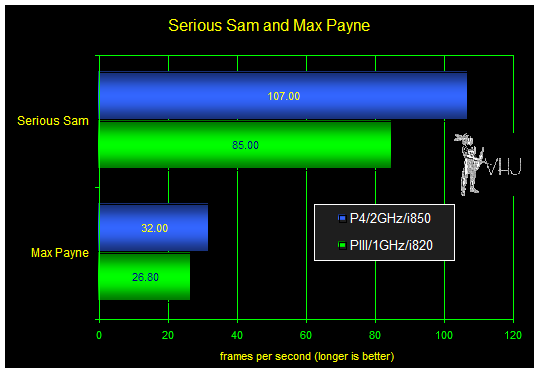
In Max Payne (1024x768x32, All Detail Max) you again see roughly a 15% performance difference between the P4 and P3 at max detail.
Serious Sam 1024x768x32, Quality Visual Settings, "Valley of the Kings" demo again demonstrates a 20% lead of the P4 over the P3. Given our findings in Quake 3, itís reasonable to conclude that the P4ís performance in Serious Sam was again impacted by the choice of a GeForce 2 Pro.
===================================
Quake 3
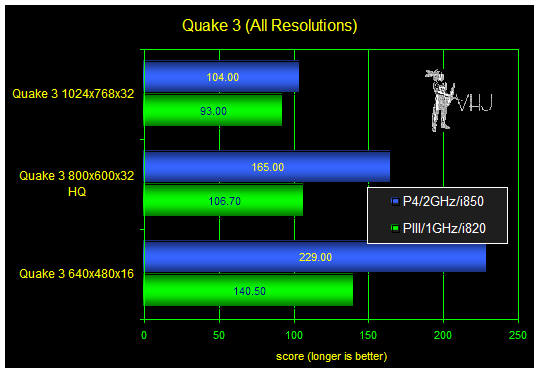
Quake 3 stands in as one of our OpenGL benchmarks and does an excellent job of illustrating both the differences between the processors and the effects of video card limitation. At low resolution the P4 scores its second-highest victory over the P3, running 39% faster. Moving to 800x600x32 HQ only drops the P4ís victory margin to 35%--meaning that the P3ís performance was still almost entirely CPU-limited, not video card limited.
Switching to 1024x768x32 max detail, however, changes the story dramatically. At that visual setting the difference between the P4 and the P3 is only 10%. By this detail level, performance between the two has become almost entirely video card limited.
===================================
Remember the 1 GHz Factor
One critical factor to keep in mind is that the numbers generated above represent a best-case scenario on the part of the VC820 system. The average VC820 system is likely NOT running a P3 1 GHz, but is running a P3 in the 667-866 MHz range. In this case, the percentage difference between an existing P3 system and the potential P4 upgrade is obviously larger.
===================================
Conclusion: Is the i850 a worthwhile upgrade to i820?
Yes, for office applications and content creation. The P4 performs an average of 33% faster than the P3 in Sysmark 2000 and 2001. While it would be nice to see a higher number given the P4ís much larger bandwidth and higher clockspeed, a 33% increase in performance will make a noticeable difference in machine performance.
Gaming is more complicated. Our conclusion here is bifurcated depending on the gamerís preferences.
If you are a gamer who prefers speed, lower resolutions, and lower quality visuals over excellent-looking games, a P4 upgrade will definitely make your day assuming youíve got a video card of at least GeForce2 GTS / GeForce2 Pro speed. Our benchmarks show an increase in speed of 35% for moving to a P4 over a P3 in Quake 3 HQ so if this is the type of mode you like to play in, youíre set.
If you are a gamer looking for excellent visuals but have a lower-power 3D graphics card, a P4 upgrade is not going to help much. As our benchmarks show, the 3D benchmarks narrow greatly when higher resolutions and more detailed graphical settings are used. If you want to play games in high resolutions and high detail settings youíll need to upgrade both your processor and your video card.
If you are wondering which P4 to buy, youíve got several options. The P4 2.0 GHz has dropped in price with the introduction of the P4 2.2 GHz, with further reductions planned for late January. Nevertheless, the 1.9 GHz or 1.8 GHz chips do remain a better value. If you do go for a P4 2 GHz, make sure to buy one labeled a P4 2.0A, or where the vendor specifically mentions a 512K cache. These P4's are based on Intel's newer Northwood design and are selling for only a slightly higher premium than the older, 256K part according to Pricewatch. The fastest P4 2.2 GHz chip remains priced well above $500, making it to expensive for consideration as an upgrade part.As long as you understand the gaming performance caveat, an i820 to an i850 upgrade makes good sense, particularly if you are using a sub-1 GHz P3 (and the slower the P3, the better sense it makes). It allows a customer to take continued advantage of a product he paid a stunningly high price for, while rewarding him with the first platform heís ever owned that actually uses it well. The performance increases are also quite noticeable.
Iíve left out the Athlon factor from this article to concentrate exclusively on RDRAM and those customers wishing to stick to an Intel-only solution. VHJ will visit Athlon upgrade potential in a later article.
===================================
Pssst!† We've updated our Shopping Page.
===================================